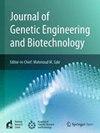In-silico, in-vitro, and proteomics analyses on repurposed drugs in targeting the small GTPase, Rho subfamily protein (Rho GTPase), and putative Rho GTPase-activating protein (RhoGAP) of Giardia lamblia
IF 2.8
Q3 Biochemistry, Genetics and Molecular Biology
Journal of Genetic Engineering and Biotechnology
Pub Date : 2025-09-24
DOI:10.1016/j.jgeb.2025.100573
引用次数: 0
Abstract
Giardia lamblia is a globally prevalent protozoan responsible for Giardiasis, an intestinal disease commonly treated with nitroimidazoles such as metronidazole, tinidazole, and albendazole. However, increasing drug resistance has reduced treatment efficacy. Rho GTPase and its regulator, putative Rho GTPase-activating protein (RhoGAP), play crucial roles in Giardia’s encystation, membrane trafficking, and metabolism. This study explores these proteins as potential drug targets. We employed sequence-based target prediction, molecular docking, molecular dynamics (MD) simulations, minimal inhibitory concentration (MIC) assays, and label-free quantitative proteomics (LFQ) to identify and validate potential inhibitors. Target sequence analysis revealed Dextromethorphan and Azathioprine as candidate Rho GTPase inhibitors, and Imatinib, Dasatinib, and Ponatinib as RhoGAP inhibitors. Molecular docking using AutoDock Vina yielded binding energies ranging from −5.3 to −8.5 kcal/mol. MD simulations via GROMACS confirmed structural compactness and complex stability. In vitro MIC assays demonstrated that Dasatinib and Imatinib inhibited RhoGAP at concentrations of 12.5 µM and 100 µM, respectively, while azathioprine inhibited Rho GTPase at 500 µM. Dextromethorphan showed no inhibitory activity. LFQ proteomic analysis further confirmed Dasatinib’s significant impact on protein expression profiles. These findings highlight RhoGAP as a promising therapeutic target in G. lamblia, with Dasatinib showing potential as a repurposed treatment for Giardiasis. Proteomic data are publicly available in the MASSIVE database under identifier MSV000097321.
针对贾第鞭虫小GTPase、Rho亚家族蛋白(Rho GTPase)和推定的Rho GTPase激活蛋白(RhoGAP)的重组药物的计算机、体外和蛋白质组学分析
贾第鞭毛虫是一种全球流行的原生动物,可导致贾第鞭毛虫病。贾第鞭毛虫病是一种肠道疾病,通常用硝基咪唑如甲硝唑、替硝唑和阿苯达唑治疗。然而,不断增加的耐药性降低了治疗效果。Rho GTPase及其调节因子Rho GTPase激活蛋白(RhoGAP)在贾第鞭毛虫的胞囊、膜运输和代谢中起着至关重要的作用。本研究探索这些蛋白作为潜在的药物靶点。我们采用基于序列的靶点预测、分子对接、分子动力学(MD)模拟、最小抑制浓度(MIC)测定和无标记定量蛋白质组学(LFQ)来鉴定和验证潜在的抑制剂。目标序列分析显示右美沙芬和硫唑嘌呤是候选Rho GTPase抑制剂,伊马替尼、达沙替尼和波纳替尼是RhoGAP抑制剂。使用AutoDock Vina进行分子对接得到的结合能范围为−5.3至−8.5 kcal/mol。通过GROMACS进行的MD模拟证实了结构致密性和复杂稳定性。体外MIC实验表明,达沙替尼和伊马替尼分别在12.5µM和100µM浓度下抑制RhoGAP,而硫唑嘌呤在500µM浓度下抑制Rho GTPase。右美沙芬无抑制作用。LFQ蛋白组学分析进一步证实了达沙替尼对蛋白表达谱的显著影响。这些发现强调RhoGAP是一种有希望的治疗兰氏贾第虫的靶点,而达沙替尼显示出作为贾第虫的重新用途治疗的潜力。蛋白质组学数据在MASSIVE数据库中公开提供,标识符为MSV000097321。
本文章由计算机程序翻译,如有差异,请以英文原文为准。
求助全文
约1分钟内获得全文
求助全文
来源期刊

Journal of Genetic Engineering and Biotechnology
Biochemistry, Genetics and Molecular Biology-Biotechnology
CiteScore
5.70
自引率
5.70%
发文量
159
审稿时长
16 weeks
期刊介绍:
Journal of genetic engineering and biotechnology is devoted to rapid publication of full-length research papers that leads to significant contribution in advancing knowledge in genetic engineering and biotechnology and provide novel perspectives in this research area. JGEB includes all major themes related to genetic engineering and recombinant DNA. The area of interest of JGEB includes but not restricted to: •Plant genetics •Animal genetics •Bacterial enzymes •Agricultural Biotechnology, •Biochemistry, •Biophysics, •Bioinformatics, •Environmental Biotechnology, •Industrial Biotechnology, •Microbial biotechnology, •Medical Biotechnology, •Bioenergy, Biosafety, •Biosecurity, •Bioethics, •GMOS, •Genomic, •Proteomic JGEB accepts
 求助内容:
求助内容: 应助结果提醒方式:
应助结果提醒方式:


